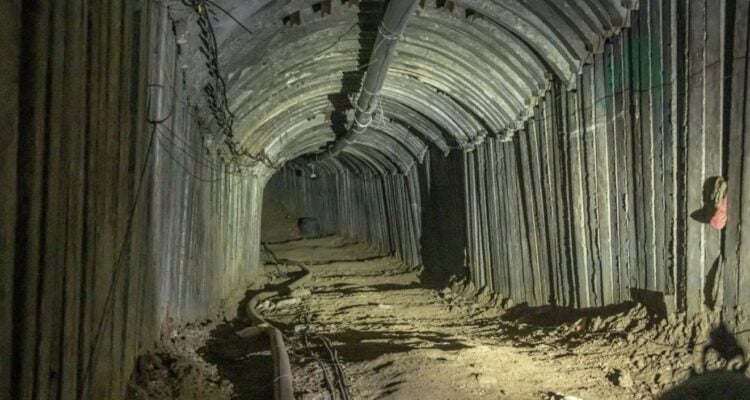One of the reasons Israel has not fully embraced tunnels is that its attention and resources are drawn to other, more pressing threats.
By David Isaac, JNS
Tunnels have proven to be a critical threat to the Jewish state. While the Israel Defense Forces certainly hasn’t ignored them, it has been slow to grasp their strategic significance.
Some argue that it still hasn’t.
“I still don’t see the necessary change in the IDF’s worldview that would allow us to better deal with this phenomenon of underground warfare,” Yehuda Kfir, a civil engineer and researcher of subterranean warfare, told JNS.
Professor Joel Roskin, a geomorphologist at Bar-Ilan University in Ramat Gan, has reached the same conclusion.
Perhaps the best supporting example is that when the IDF built its defensive “smart wall” (completed in 2021) between Israel and the Gaza Strip, it continued to let Hamas build all the underground infrastructure it pleased as long as it stayed on its side of the fence.
The resulting underground city in Gaza, from which Hamas could command and control its forces, send them out to attack and recall them to shelter in place, has served to prolong the war and prevent Israel from saving the remaining hostages.
It allowed Hamas leader Yahya Sinwar to elude Israeli forces for more than a year.
Sinwar himself (along with 1,026 others) was released from Israeli prison in 2011 in exchange for IDF soldier Gilad Shalit—who had been kidnapped by terrorists who emerged from a tunnel.
Kfir posits that Oct. 7 wouldn’t have happened if not for Hamas’s extensive tunnel system. “Sinwar would not have dared invade as he did without this underground system from which he could continue to survive and function,” he told JNS.
Kfir and Roskin’s conclusions have been echoed elsewhere.
Asher Katz, an IDF reservist specializing in tunnels, said in an interview with David Harris of the Jewish Broadcasting Service in late September that it wasn’t until 2021 that it dawned on Israel that the tunnels were more than a Hamas tactic, (i.e., a way to move fighters from one place to another).
They were rather Hamas’s entire “strategic thesis,” he said; a means to fight, hide and survive.
Hamas was thinking strategically, but Israel was thinking tactically, Asher said, adding, “Israelis were super good at solving problems. Give us a problem, we’ll solve it. I don’t think we’re that good at strategy. Or we haven’t been good enough at strategy.”
Former U.S. Ambassador to Israel David Friedman told interviewer Dave Rubin on Oct. 9 that if he had one criticism of Israel’s Gaza war it was that it was taking too long, a fact he attributed to Hamas’s tunnel system.
“They [Hamas] got 350 miles’ worth of terror tunnels,” he said, adding that the Israelis didn’t understand what they were dealing with. “Hamas, I say, had the greatest home court advantage in the history of ground warfare.”
The IDF has significantly improved its tunnel operations over the last year, Kfir acknowledges, pointing to the army’s decision to move its forces underground in tandem with its above-ground forces.
In the clip below, IDF Brig. Gen. Dan Goldfus describes such simultaneous troop movements.
Israel is using the enemy’s own tunnels to advance. But Kfir said that’s not enough, that Israel is still leaving the initiative to the enemy.
The modern battlefield has become multi-level, but Israel is neglecting an entire level, he said. He likens it to a Navy without submarines, one that operates only on the surface.
Kfir and Roskin, who concede they’re currently in the minority on the topic, argue that Israel must build its own attack tunnels. The concept may sound “sci-fi,” but they depict a subterranean battlefield in which Israeli forces dig tunnels to carry out their own operations and to counter those of the enemy.
Said Roskin, “If you don’t dig yourself and experience the construction process, the routine of life within a tunnel, you don’t really understand what it’s all about.”
Kfir and Roskin recently distributed a report on offensive tunneling to various individuals in the IDF, from engineering, intelligence, research and development and other units. “Nobody called us even to discuss it,” said Roskin.
One of the reasons is that responsibility for tunnels is diffuse. There isn’t a single address for tunnels in the army. Kfir and Roskin argue an organizational change needs to take place—the establishment of an IDF branch dedicated solely to underground warfare.
The IDF tells JNS that tunnels are handled by Yahalom, a special forces unit of the Israeli Combat Engineering Corps. However, Yahalom’s duties include more than just tunnels.
When asked by JNS about a special tunnel lab set up in 2018, the “Technological Laboratory for Tunnel Detection and Locations,” which specifically focuses on detecting and locating tunnels, the IDF said that it operates under the Gaza Division, separate from Yahalom.
“We have been advocating, given the wide ranges of uses of tunnels by Hamas, and now by Hezbollah, a separate branch, or at least a large research-to-engagement unit in the military,” said Roskin.
The IDF is only now learning the extent of Hezbollah’s tunnels in southern Lebanon. Early last week, it uncovered an 800-meter (~0.5 mile) tunnel designed as a launching pad for an attack on northern Israel.
According to reports, Hezbollah had planned its own Oct. 7-style massacre on Israel’s northern communities (its scale would have been far worse than the Hamas attack, the reports say).
After visiting the tunnel, Channel 14’s military reporter Noam Amir said it was larger than the IDF’s 800-meter estimate, because there were turn-offs to rooms, one containing a giant generator, another a huge hangar, and others leading to sleeping quarters, kitchens and weapons stores. “I walked for 45 minutes, which felt like several kilometers,” he said.
“They [Hezbollah] have food there for many months. With a long shelf life, you could divide it up for years. It’s not the dates and nuts that were given to the terrorists in the tunnels in Gaza. And you see mopeds. And you see a room for terrorists with plasma TVs … And you say to yourself, what have they built under our noses for more than two decades?” said Amir.
One of the reasons Israel has not fully embraced tunnels is that its attention and resources are drawn to other, more pressing threats.
“Missiles travel 15,000 miles per hour. Tunnels advance one-to-five meters per day,” Roskin pointed out.
Underground warfare is not just Israel’s problem, but a world problem, Kfir said. This is in part because bad actors have been inspired by Hamas’s ability to last as long as it has, despite Israel’s entire military and political establishment being mobilized against it.
America is quietly concerned about China invading Taiwan via tunnel, Kfir noted, saying it is possible engineering-wise to dig under the Taiwan Strait.
“The Chinese are taking over the world market in TBM (Tunnel Boring Machines),” he said. “There is almost no company today in this field that is not controlled by them.”
Will tunnels again become a threat from Gaza? That fear is already being aired by some. IDF Lt. Col. (ret.) Jonathan Conricus has voiced his concerns that the military may not be doing enough to counter a future tunnel threat under the Philadelphi Corridor along the border between the Gaza Strip and Egypt.
The IDF is going after specific tunnel entrances in a “pinpoint solution” rather than a “systemic solution” that deals with all the tunnels, Conricus told JNS. “What’s needed is to create a permanent change, or at least one that’s more long lasting.”
Conricus suggests an underground barrier, “a type of defensive wall,” similar to what Israel built around the Gaza Strip, which prevented Hamas from using tunnels in their Oct. 7 attack.
It’s called a “slurry wall” and involves “digging a deep trench, dozens of meters deep, and filling it with concrete that has sensors in it, that basically cuts across the border. It doesn’t make it impossible to dig a tunnel, but it makes it very, very difficult,” he said.
While Israeli Prime Minister Benjamin Netanyahu has stated that Israel will keep troops in the Philadelphi Corridor, Conricus said there are no guarantees.
Pressure is being applied by the United States and Egypt, putting a damper on the idea. A slurry wall would give Israel at least some measure of control over what happens under the Strip if it is forced to leave, he said.
The Philadelphi Corridor is where all the problems started, Kfir noted. In the 1980s, Israel had its first encounter with tunnels in the form of underground smuggling by terrorists.
The IDF struggled to counter it. The terrorists’ initial success led them to expand their use of tunnels, planting explosives under IDF outposts. They blew up their first in 2001.
Roskin said Israeli troops will need to be on the border.
“If Israel wants to have control of the Gaza Strip, they have to control the Philadelphi Corridor, hands-on, on the ground,” he said.
Even IDF officers who advocated for the 2005 disengagement from Gaza argued at the time that Israel must keep the Philadelphi Corridor.
“They were pretty shocked that [then-Prime Minister] Ariel Sharon was going to give up Philadelphi. We’ve seen the price we’ve paid,” said Roskin.





